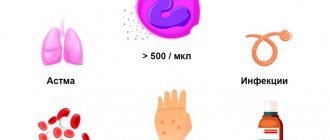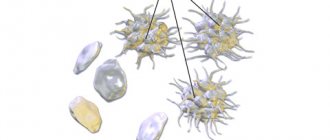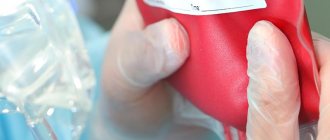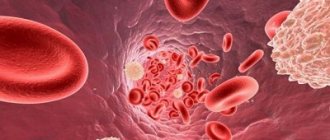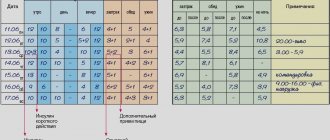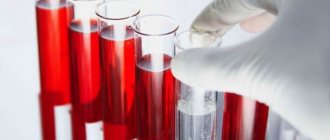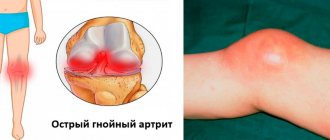General practitioner
Shekinah
Natalya Nikolaevna
15 years of experience
General practitioner
Make an appointment
While still at school, children learn about white blood cells and the importance of the many functions they perform in the body. However, an excess of even such useful enzymes in the blood can create health problems. What kind of disease is this in adults - leukocytosis?
Leukocytosis is a process of changes in the composition of the blood, which results in an increase in the number of leukocytes. For adults, the norm for leukocytes is considered to be 9000 in 1 μl of peripheral blood. Exceeding these values may indicate a problem. The changes that occur in the composition of the blood are the body’s protection against certain influencing factors. For specialists, an increase in the number of leukocytes becomes one of the important signs when diagnosing a number of pathologies.
Main causes of leukocytosis
There are many factors that can influence changes in blood composition. The following are various causes of leukocytosis in the blood in adults.
Often the disease is provoked by infections. One of the main functions of leukocytes is to maintain anti-infective immunity. Therefore, the appearance of foreign pathogens in the body leads to an increase in the number of white blood cells in the blood. Different types of pathogenic microorganisms provoke different types of leukocytosis.
With the bacterial type, the number of neutrophils and monocytes increases. Their action in fighting infections can be compared to an “oxygen explosion” that literally destroys hostile pathogens.
Viral infections provoke an increase in lymphocytes. This type of leukocyte produces specific antibodies to trigger the apoptosis mechanism in viral cells.
Helminthic infestations – the level of eosinophils changes. They contain a cationic protein that can act on helminths that have infected the body and negatively affect the metabolic processes within them.
The causes of leukocytosis can be systemic diseases:
- diffuse connective tissue diseases (for example, dermatomyositis or systemic lupus erythematosus);
- joint diseases (rheumatoid arthritis, etc.);
- systemic vasculitis (giant cell arteritis, nonspecific aortoarteritis).
The exact mechanism of leukocytosis in systemic diseases has not been established. Presumably, the production of leukocytes is provoked by cytokines and mediators that are formed during the process of rheumatic inflammation.
Allergies become the main cause of the development of eosinophilic leukocytosis.
Blood diseases - pathologies such as leukemia, polycythemia, lymphomas, cause the development of hyperleukocytosis. It develops against the background of oncological transformations occurring in bone marrow stem cells. As a rule, the result is severe acute leukocytosis.
Other causes of leukocytosis:
- endocrine type disorders;
- lesions that cause large-scale tissue destruction (for example, extensive burns);
- various types of toxic effects on the bone marrow;
- malignant neoplasms;
- primary immunodeficiency;
- diseases of the lungs and respiratory tract;
- diseases of dermatological type, etc.
Relative lymphocytosis:
Lymphocytosis can be relative or absolute. In relative terms, the total number of all leukocytes remains within the normal range, but the percentage of lymphocytes in the blood is increased. However, their absolute number has not changed in any way. How is this possible? It’s very simple: the apparent increase in the number of these cells is due to the fact that the number of other leukocytes decreases.
This form of lymphocytosis sometimes occurs normally. For example, this can be observed in the blood picture of babies. At the beginning of life, they experience the so-called neutrophil-lymphocyte crossover - a multidirectional change in the number of neutrophils and lymphocytes, which occurs during the development of the immune system.
If lymphocytes are elevated in a child, this may be a variant of the norm, but in adults, relative lymphocytosis most often indicates a disorder.
For example, with a long-term purulent-inflammatory disease (protracted pneumonia, furunculosis), the immune system is gradually depleted. Neutrophil cells turn into pus; their “reserve” does not have time to renew itself, so they can decrease in number. Against their background, the content of other leukocytes in the blood seems increased, even if their “piece” number is normal. Relative lymphocytosis occurs. But if the same inflammation is acute, has barely begun, then the opposite may be true: the immune system intensively produces neutrophils, there are more of them in the blood, and because of this, it seems that a person has reduced lymphocytes.
If lymphocytes are elevated, the reasons for this may also be the presence of hyperthyroidism (increased secretion of thyroid hormones), splenomegaly (increased function and increase in size of the spleen) and other diseases, including very serious ones.
Complications
Since this disease is not independent, it also cannot be a predictor of any complications or consequences. All consequences that occur in the patient (including death) are directly related to the disease against which leukocytosis developed. Therefore, a serious excess of any type of leukocytes in the blood is a reason to conduct an in-depth examination to find out the true cause. Such a need may arise even if a person feels absolutely healthy.
Lymphocytosis in viral diseases
Diseases caused by viruses are a common cause of lymphocytosis. In adults, it occurs with influenza and acute respiratory infections. In children - with chickenpox, measles, rubella. As a rule, patients are diagnosed with moderate lymphocytosis, which occurs as the symptoms of the disease increase. After recovery, blood counts return to normal.
The exception is infectious mononucleosis caused by the Epstein-Barr virus. The pathogen belongs to the herpevirus family. It multiplies in B lymphocytes and stimulates their growth. Adults and children are susceptible to this disease, but in childhood the risk of getting sick is much higher. In middle-aged and mature people, the pathology occurs without pronounced symptoms, since specific immunity has already been formed.
Against the background of infectious mononucleosis, persistent moderate lymphocytosis is observed. In addition, atypical mononuclear cells are found in the blood - large cells characteristic of the disease.
Lymphocytosis in bacterial infections
Some diseases caused by pathogenic bacteria also result in lymphocytosis. As a rule, we are talking about diseases that have a chronic course. In adults, lymphocytosis is diagnosed against the background of tuberculosis, syphilis, brucellosis, and various forms of typhoid diseases. In children, a similar condition is observed with whooping cough.
Changes in leukocyte counts depend on the nature of the pathology. In the chronic form, there may be a slight or moderate increase in levels that persists for several months or even years. If the disease worsens, the number of lymphocytes increases as symptoms increase.
Classification of leukocytosis
A shift in leukocytosis does not always indicate a disease. According to biological characteristics, two types are distinguished:
- physiological leukocytosis;
- pathological increase in leukocytosis.
The physiological type is the norm of leukocytosis. It occurs in absolutely everyone and does not pose any danger. In certain circumstances, even a healthy person has moments in everyday life when an increase in white blood cells occurs. Factors influencing this physiological process may be different. For example, there is the concept of food reactive leukocytosis. As a rule, it occurs 2-3 hours after eating. Another common factor is playing sports or other intense physical activity. As a result of muscle work, the level of leukocytes temporarily increases. The physiological type of leukocytosis in women during pregnancy is a completely normal phenomenon during the second trimester of pregnancy.
Pathological leukocytosis in the blood develops against the background of diseases, therefore, correction of the level of leukocytes is carried out by treating the disease against which it developed.
The following types of leukocytosis are distinguished.
Depending on the degree of increase in the level of leukocytes:
- moderate leukocytosis - an increase in the level from normal to 15,000;
- high leukocytosis – level range from 15,000 to 50,000;
- hyperleukocytosis - the concentration level exceeds 50,000. This degree of the disease is characterized by the presence of a large number of unformed white cells;
By type of leukocytes that exceeded the norm:
- neutrophilic or neutrophilia. The excess of neutrophils is more than 75%. Changes can be provoked by suppurative processes, as well as various bacterial infections;
- lymphocytic or lymphocytosis. The level of lymphocytes exceeds 38% in adults (for children under 7 years of age, this figure is 55%). The cause may be lymphoproliferative diseases, as well as viral infections;
- monocytic or monocytosis. The level of monocytes exceeds 10%. Common causes include septic endocarditis, granulomatous processes, protozoal infections;
- eosinophilic or eosinophilia. Exceeding the norm is more than 5%. The cause may be allergic reactions, a number of lung diseases, helminthic infestations, etc.;
- basophilic or basophilia. Basophil level more than 1%. This shift in leukocytosis is very rare. Among the causes, experts identify nonspecific ulcerative colitis, polycythemia vera, and allergies.
Correction
There are no direct ways to normalize the concentration of lymphocytes. To combat lymphocytosis, it is necessary to treat the underlying pathology that caused the increase in lymphocytes. Minor short-term lymphocytosis that occurs due to stress, taking medications, or during recovery from a cold does not require therapy. In case of long-term lymphocytosis, both absolute and relative, you should consult a doctor.
For many viral infections (varicella, rubella, ARVI), no etiotropic therapy has been developed to date. For their treatment, pathogenetic and symptomatic methods are used - plenty of hot drinks, antipyretic, anti-inflammatory drugs. For catarrhal syndrome, gargling and irrigating the throat with antiseptic solutions and sprays are prescribed. In the first days of influenza, the use of antiviral drugs (oseltamivir, rimantadine) is effective.
There is evidence of a reduction in the number of complications of infectious mononucleosis in adults by prescribing acyclovir and valciclovir. For bacterial infections, antibiotics are prescribed, for tuberculosis, a combination of anti-tuberculosis drugs. If the cause of lymphocytosis is a lymphoproliferative disease, then long repeated courses of chemotherapy are required. If conservative treatment of chronic myeloid leukemia in adults is ineffective, allogeneic bone marrow transplantation is used.
Symptoms and signs of leukocytosis
An increase in the level of leukocytes cannot be considered as an independent disease. It always develops against the background of another disease, and therefore does not have its own symptoms and clinical manifestations. Often, in the early stages, leukocytosis in men and women has no symptoms; a person may even think that he is completely healthy. However, there are a number of symptoms that you should pay attention to. Especially if a person cannot explain their nature, for example:
- elevated body temperature for a long time;
- frequent bruising and bleeding;
- general weakness, feeling of malaise;
- frequent dizziness or fainting;
- tingling and pain in the limbs;
- loss of appetite or weight loss for no apparent reason.
Are you experiencing symptoms of leukocytosis?
Only a doctor can accurately diagnose the disease. Don't delay your consultation - call
When to see a doctor
If you experience a general feeling of malaise or one of the symptoms described above for no apparent reason, you should consult a specialist. Such symptoms are characteristic of a large number of diseases and can also be a sign of leukocytosis. Therefore, you should contact a competent specialist for advice. JSC “Medicine” (clinic of Academician Roitberg) employs experienced specialists with extensive experience and high qualifications. The clinic is located in the center of Moscow: 2nd Tverskoy-Yamskaya lane, 10.
Diagnosis of leukocytosis
The diagnosis of leukocytosis is established based on the results of a clinical blood test. An appointment with a general practitioner takes place in two stages: taking an anamnesis and examining the patient. After analyzing the data obtained, the doctor prescribes additional studies to identify and confirm the disease that caused leukocytosis.
Let's consider the types of possible research.
- Detailed blood test and biochemical blood test. Leukocytosis is determined in the blood smear for the presence of toxic granularity of neutrophils, as well as atypical mononuclear cells.
- Detection of the pathogen using bacterial culture of blood, urine, and sputum. Identification of the pathogen will allow the exact cause to be determined and effective treatment to be prescribed.
- Allergy diagnostics. To confirm the allergic nature of leukocytosis, studies measure the level of immunoglobulin E using ELISA. Skin and provocative allergy tests may also be performed.
- Radiography. This method can be used to examine chest organs, joints, etc.
- Ultrasound. An effective diagnostic method for a large number of diseases. Ultrasound helps to identify, for example, an increase in the size of the kidneys, compaction of the pyelocaliceal system, it is also important for identifying vegetation on the valves, etc.
Research in our clinic is carried out using the most modern equipment, as quickly as possible.
Treatment of leukocytosis
Features and causes of appearance do not provide for symptomatic treatment of leukocytosis. Therapy is prescribed after the underlying disease has been established, the development and progression of which has provoked a jump in the level of leukocytes. Accordingly, treatment methods in each individual case will be very individual.
Antibiotics are used to treat infectious diseases. Steroid drugs can be used to eliminate inflammation. Reducing uric acid in the body with the help of special drugs helps prevent the destruction of body tissues, which can also cause leukocytosis, etc. When talking about the treatment of leukocytosis, we are talking about the disease that caused it.
At our multidisciplinary medical center, doctors prescribe safe and effective treatment using an individual approach and many years of experience.
Hematological diseases
High lymphocytosis is observed in diseases of the hematopoietic system and lymphatic tissue. Malignant diseases cause proliferation - uncontrolled cell division and tissue growth. In myeloproliferative and lymphoproliferative diseases, a corresponding change in cells in the bone marrow occurs.
The most common hematopoietic diseases that cause lymphocytosis are lymphosarcoma, lymphogranulomatosis, and chronic leukemia. Lymphocyte counts in such pathologies can reach 70-90%. Growth occurs gradually, reaching a maximum several years after the onset of the disease. To treat lymphocytosis, it is necessary to address the underlying cause that led to an increase in the number of lymphocytes. Chemotherapy courses and bone marrow transplants help bring lymphocyte counts back to normal.
In addition to malignant diseases of the hematopoietic system, lymphocytosis occurs against the background of anemia caused by deficiency of vitamin B12 and folic acid. In patients who have undergone blood transfusion, an increase in the number of lymphocytes may appear as one of the signs of post-transfusion syndrome.

